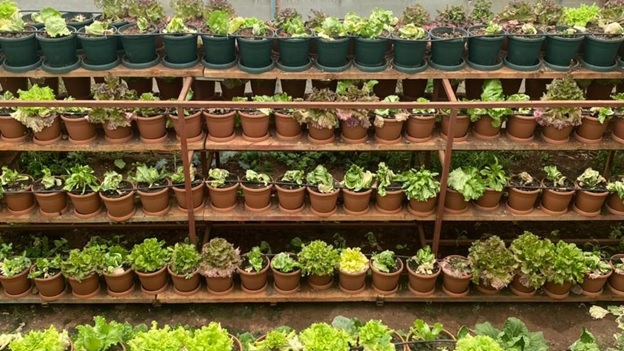
Urban gardening or urban agriculture is where people practice cultivation, mainly of food, in and around urban areas peculiarly the scheme focuses on traditional cultivation of crops in urban centers.
Cognizant of the fact that urban gardening has myriads of advantages like ensuring food security and making diets balanced for the community especially residing in urban areas, The Ethiopian Herald had a stay with Murad Gobena, an agro economist graduated from Haramaya University in agricultural economics, to have a piece of professional standpoint regarding urban gardening.
He said, “Urban gardening is noticeably being taken up and has been a successful substitute—a shift from the traditional thinking that the cultivation of crops can only be carried out in the rural areas with urbanization, and more and more people would like to do their farming where they are in urban localities.”
As to Murad, urban agriculture, urban farming, or urban gardening is the practice of cultivating, processing, and distributing food in or around urban areas. It can also involve animal husbandry, aquaculture, agroforestry, apiculture/urban beekeeping, and horticulture. These activities occur in semi-urban areas as well.
As to him, the growth of plants in urban areas comes in many forms and is influenced by various factors such as land space, topography, capital requirements, and the type of plants grown. Urban gardening can, therefore, be done differently and includes aspects such as community gardens, urban farms.
Urban gardening is mainly characterized by the cultivation of crops such as fruits, vegetables, and the rearing of chicken and fish in the urban and peri-urban centers. It can also be done in front and backyards, balconies, sunrooms, indoor greenhouses, rooftops, or squares, he added.
He further elucidated that things such as containers, old tires, barrels, unused buckets, shoes, watering cans, window-boxes or kiddie pools can be used to grow food crops, fruits plants, flowers and shrubs for environmental decoration.
Urban gardening is undeniably a venture that helps the urban society in social and economic ways by stimulating the local economy and serves as an effective means of securing a family food security.
Apart from helping the effort to ensure food security, urban gardening is significantly useful in putting school lessons into practice and can boost children’s interest in agriculture as it gives students an opportunity to try things out at home and more so., Yes, students easily connect their lessons to real-world gardening and how it is done through urban gardening thereby increasing their stock of knowledge about cultivating plants.
According to Murad, urban gardening increases the land area utilized for agriculture thereby increasing food security as the population soars and arable land is constantly facing depletion.
Undeniably, urban gardening is of economic importance and creates jobs as it has made towns or cities economic base expand by creating economic activities through the production, packaging, and selling opportunities for food, vegetable, herbs, and fruit products.
He said urban gardening guarantees the consumption of healthy foods that are predominantly organic and home-grown ones free of artificial fertilizers, pesticides, and herbicides. Besides, urban gardening does not contaminate as much soil as in the traditional agricultural setting, through fertilizers, hazardous chemicals, and other wastes.
“Most urban gardens use containers and have limited space for draining excess water. True, instead of filling the limited space with crops and lacking a spot to walk on, it is advisable to use the space upwards. In addition to utilizing the vertical space in a more efficient way, vertical growth of crops can serve more purposes. If a container has a wall pocket, for example, people can plant more crops with additional commitments or having to use more containers,” he added.
As to Murad, urban agriculture comprises diverse forms of small-scale agricultural production in the city, conducted in public space, private gardens or on rooftops. Actors in urban gardening are frequently driven by their concern for food safety.
According to Murad, many urban dwellers are these days getting benefits out of their engagements in the activities undertaken in their backyard, surrounding open spaces, using a number of containers for producing vegetables, fruits, forest trees and the likes. Such a dedicated involvement would be of dual significance: backing the effort exerted to ensure food security and keeping the balance of nature.
Hence, he stated operators of urban agriculture are expected to well embark on this gratifying scheme and let others to draw important lessons with a view to getting the practice well expanded and widely exercised.
No matter how small plots of land in some areas to grow fruits and vegetables as required, the land management applied matters the most. Apart from the sidewalks and fallow urban land, gardening can also be observed in public and particularly sacred institutions, such as churches and mosques.
Obviously, he added many people from rural areas moved to the city in search for higher income opportunities. Accordingly, most urban dwellers still have rural ties. These connections to kin in the countryside are reevaluated in the urbanites’ search for clean and safe vegetables.
The production sites of clean and safe vegetables, looking at the physical spaces of urban gardening and the practices in situ, as well as at the discursive and consumptive practices constituting rural space.
In fact, those who receive vegetable boxes are only able to do so because they have strong social ties to their rural hometowns. The feeling of belonging is furthermore expressed in urban gardeners’ responses of how they acquired their gardening skills, with many explaining that they were able to cultivate their own produce because they grew up in the countryside. Accordingly, the presented urban gardening practices are not actually so different from the manifestations of urban gardening observed in towns and cities across the nation.
While the ability to feed city dwellers may not be the basis of urban agriculture business models, the additional benefits it offers are driving the emergence of alternative models.
In a nut shell, urban agriculture obviously provides direct economic benefits such as job creation and property development. These non-monetary benefits push some actors, such as municipalities, to invest in projects that go beyond the logic of economic profitability. There are also benefits in terms of food safety, an issue that was highlighted by the onslaught of supermarkets at the start of lockdown. The return to short circuits reduces food dependency and increases the resilience of territories.
It is also necessary to find a balance between social and environmental benefits and economic viability of urban agriculture. As the objective of farm profitability must not be achieved at the expense of environmental benefits, urban agriculture operators have to attach due emphasis to social and environmental safety.
Urban farming is the practice of growing fresh produce within the city for individual, communal, or commercial purposes. Urban farming often makes use of vacant lots, rooftops, and abandoned or repurposed indoor spaces to grow crops, such as fruits and vegetables. These spaces can be located on top of or near residential buildings, schools, institutions (such as hospitals, nursing homes, and universities) or commercial spaces, such as supermarkets, restaurants, and marketplaces.
As more and more people live in cities, and thus farther away from their food sources, urban farming seeks to bring produce closer to the consumer for economic, environmental, and social reasons.
Murad further stated that as many urban areas lack both green spaces and fresh food, urban gardens have to flourish as a solution that can engage the community, add greenery to the cityscape, and produce healthy, affordable, and local fruits and vegetables.
He said, “Basically, urban farming comes in various shapes and sizes, which tend to fit into three broadgroupings: community gardens, rooftop farms, and indoor vertical farms.”
He said community gardens are often located on vacant urban lots and are great tools for increasing social capital in a neighborhood. These are small to medium-size plots of land that are open to the community. They enable neighbors to grow their own produce on small, allotted patches of a garden or for collective use on a shared plot.
Rooftop farms are another form of urban agriculture, whereby a building makes use of its rooftop to grow crops. These buildings range from residential to commercial buildings and can even include skyscrapers. They are often used as garden space for recreational use-on top of residential buildings.
The third one, according to Murad, is vertical farming uses both hydroponic and geoponic techniques to grow crops using vertical height and/or stacked layers. Vertical farms are usually placed indoors or inside of a greenhouse, and use controlled-environment agriculture, which involved artificial lighting, climate-control technology, and other automated and controlled agricultural inputs that are often monitored remotely.
BY MENGESHA AMARE
The Ethiopian Herald August 24/2023





